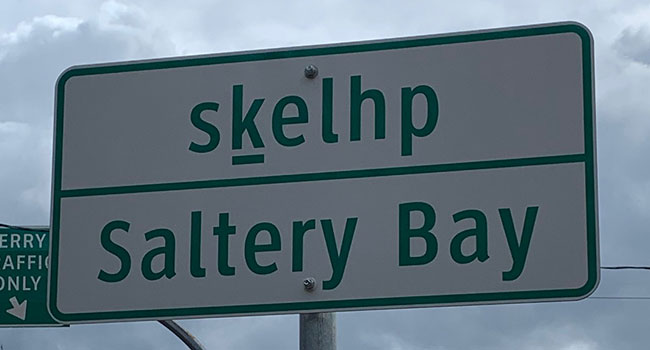 As we continue to hunker down in our Sunshine Coast house to avoid COVID-19, and come to emotional grips with the pandemic, it’s wonderful to have good news.
As we continue to hunker down in our Sunshine Coast house to avoid COVID-19, and come to emotional grips with the pandemic, it’s wonderful to have good news.
We got some today.
I just saw a new road sign go up in what has been called Saltery Bay since the early 1900s.
Fair enough, you might say, to name a place for a settler industry (salting salmon for barrel transport before refrigeration) perhaps.
But what about the prior traditional place names used by Indigenous peoples who have lived for thousands of years on this coast?
That was exactly the question I wondered when we bought our acreage in 2004, with the intention of eventually retiring on the property located at the mouth of Jervis Inlet, at the north end of the Salish Sea.
When I first got my hands on a nautical chart for the area, it was as if it had been filled with place names celebrating my old British grandfather’s heroes:
- Nelson Island (named after Vice-Admiral Horatio Nelson, Royal Navy, who famously died in the Battle of Trafalgar);
- Hardy Island (Vice-Admiral Sir Thomas Hardy, Royal Navy, who cradled Nelson’s head as he laying dying, and to whom Nelson uttered his dying comment, “Kiss me, Hardy”);
- Mount Troubridge (Rear Admiral Sir Thomas Troubridge, Royal Navy, and later First Lord of the Admiralty);
- Hotham Sound (Admiral William Hotham, Royal Navy, commander of the Mediterranean Fleet).
While I was raised in a family with great respect for the British Navy, I found their place names in our new front yard overbearing, pretentious, and completely inappropriate for the land and seascape they described.
I was aware we had bought property on shishalh (anglicized many years ago as Sechelt) Coast Salish traditional lands. But there were no longer any shishalh residents in our immediate vicinity.
To the northwest in Thunder Bay (there we go again!), we’re bordered by the Tla’amin Nation, whose lands and traditional territories are located on the upper Sunshine Coast. Their comprehensive knowledge of place names starts just above our property.
Luckily, back in 2004 I asked an old pal, Randy Bouchard, a northwest coast linguist, if he knew of any place names for our region.
Once he saw our property on the map, he found one: Skelhp. It had been collected in a linguistic survey conducted in the 1950s from an elderly shishalh woman. It means: “The place where the ancients first dropped down from the heavens and taught us how to make paddles out of yew wood.”
When reconciliation defies the common good by Rodney Clifton
So we started to call our place Skelhp House.
Not everyone in our extended family, or friends and neighbours, got the point. Some in the millennial world saw the act as virtue signalling. Some older friends exaggerated their pronunciations and mimicked vocal struggles to pronounce the word.
But most people simply asked how to say it, listened and then complied with the new (actually old) place name.
My Indigenous pals got it immediately, however. To them it was obvious.
I enjoyed having a local language place name from the start. Why not dignify your new home with its traditional name, thoughtfully created, hundreds if not thousands of years ago to precisely describe a locality in terms of distinguishing characteristics?
Now I wish I knew what all the other nearby bays, peaks and beaches are named!
And I’ve wondered some more about Skelhp. Could it be the place on the south B.C. coast where the people who travelled inland from the Beringian land bridge (first doing so perhaps 20,000 years ago), came from the interior Cariboo plateau to meet the people who had paddled down the coast?
Such a meeting could easily have occurred in the past several thousand years, as the glaciers blocking the way southward melted.
There are many local archaeological sites with this time depth. There’s one at Skelhp, in the Mermaid Cove provincial campsite.
We haven’t completely given upon on old Nelson, Hardy or Troubridge. Their names are still on the nautical chart, and are often used by me to try to humorously illustrate the importance of Indigenous reconciliation beginning with the basics.
When I’m in a generous mood, I even think the old admirals finally get it!
Mike Robinson has been CEO of three Canadian NGOs: the Arctic Institute of North America, the Glenbow Museum and the Bill Reid Gallery. Mike has chaired the national boards of Friends of the Earth, the David Suzuki Foundation, and the Canadian Parks and Wilderness Society. In 2004, he became a Member of the Order of Canada.
The views, opinions and positions expressed by columnists and contributors are the author’s alone. They do not inherently or expressly reflect the views, opinions and/or positions of our publication.


